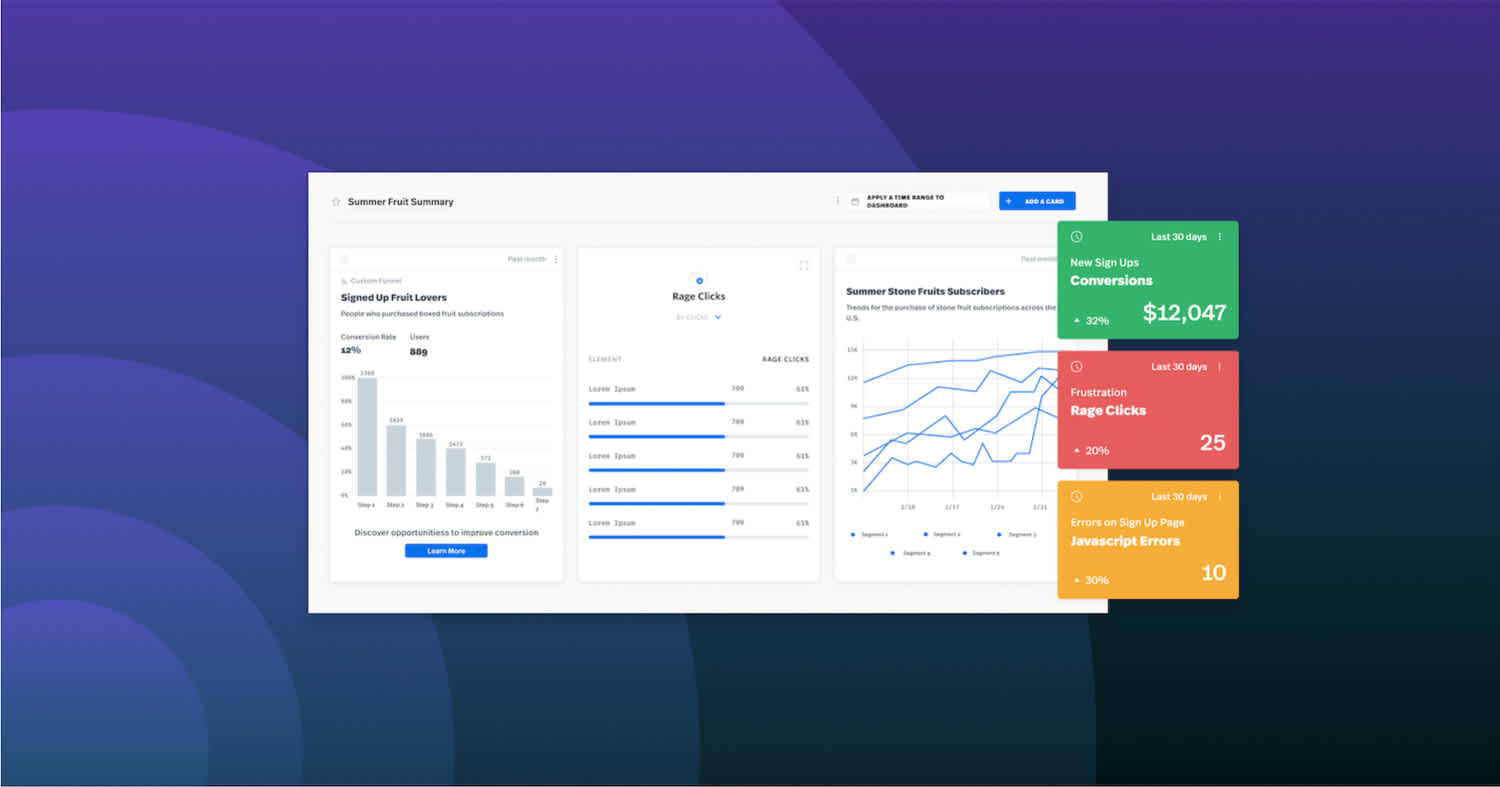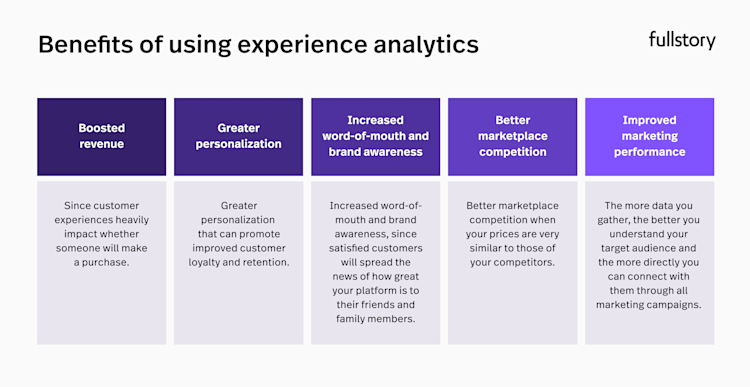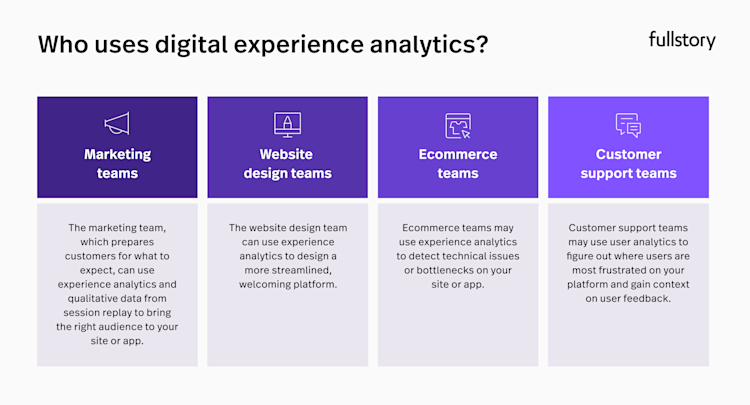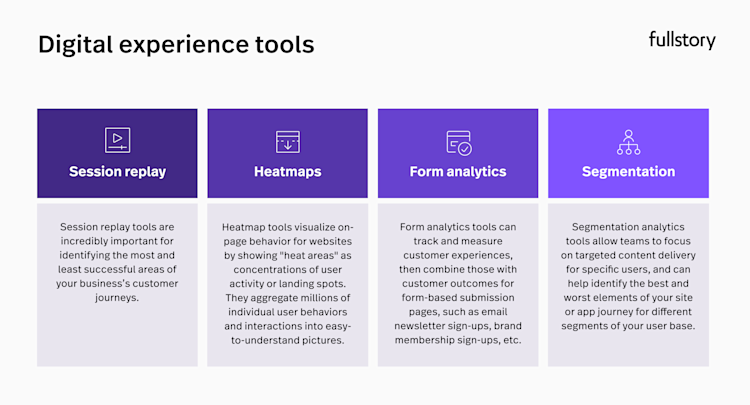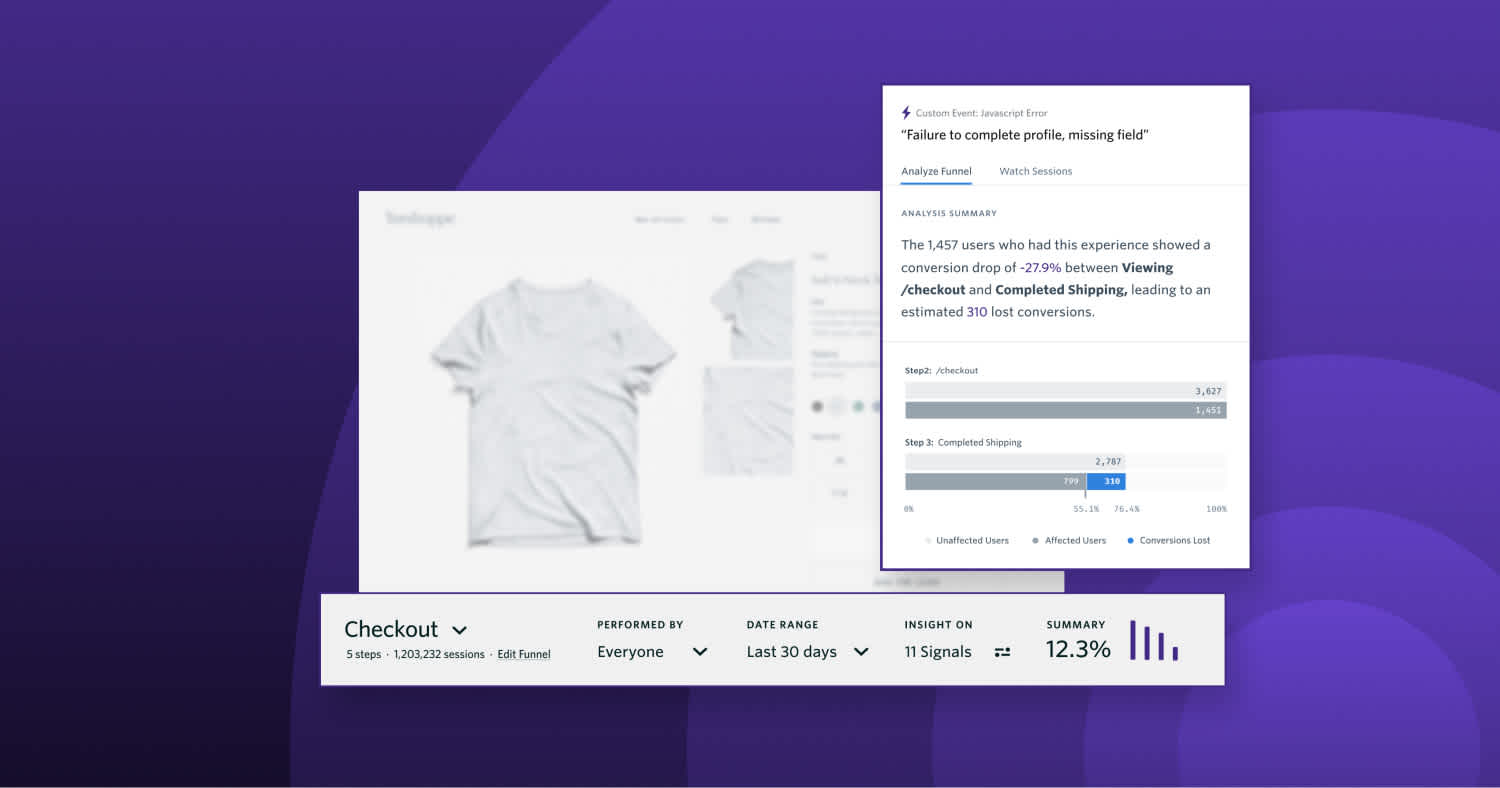What is digital analytics?
Digital analytics helps you understand how users interact with your digital products - but it goes way beyond basic metrics. While traditional analytics might tell you about page views and bounce rates, modern digital analytics reveals the complete story of your users' experience.
Think of it as a sophisticated tracking system that captures everything from user journeys and conversion patterns to signs of frustration and technical hiccups. It shows you where users get stuck, what makes them convert, and what drives them away.
Today's digital analytics focuses on three key areas:
Behavioral patterns - understanding not just what users do, but why they do it
Technical performance - tracking issues like load times and errors that impact the experience
Business impact - connecting user behavior directly to revenue outcomes
The real value comes from understanding the customer sentiment between the clicks - those subtle signals that indicate user satisfaction or frustration. With the right digital analytics setup, you can spot problems before they impact revenue, identify optimization opportunities, and create experiences that truly work for your users.
When you have this level of insight, you're not just collecting data - you're gathering actionable intelligence that drives better business decisions.
What is digital experience analytics?
Digital experience analytics involves understanding, measuring, and improving user interactions across digital platforms like websites and apps. It captures detailed insights into user behavior, intent, and sentiment, while identifying friction points and opportunities to enhance the overall customer experience. By analyzing patterns and performance metrics, it empowers teams to create seamless, intuitive, and effective digital journeys.
Think of a typical user experience (UX) on a popular application. The UX describes how customers interact with the application, how they navigate its features, and whether they are satisfied with their time on that app.
Digital experience analytics analyzes how users experience applications/platforms with as much detail as possible. This broad category of web analytics enables statisticians and analysts to examine many different types of data.
Digital experience analytics solutions include various capabilities and tools to both measure and analyze customer experience issues. Fullstory’s behavioral data platform, for example, offers various measurement tools like funnels, conversion measurements, heatmaps, click maps, user journeys, and other engagement data—often in real-time.
Ultimately, digital experience analytics is valuable since it automatically measures up to billions of different user sessions and trillions of individual user behaviors. More importantly, Fullstory combines digital experience analytics with customer journey analytics to analyze those behaviors and reveal what’s happening during every step of their journey on your website or app.
Information is power, and digital experience analytics is one of the most comprehensive ways to get that information.
Why use digital experience analytics?
Digital experience analytics will help you bolster online traffic across the board. Online traffic is growing across the board–some statistics indicate it grew by 25% in 2020 alone–but if you want your brand to thrive, rather than just survive, in the modern market, you need to know how to maximize that traffic growth as much as possible.
It’s estimated that about 67% of customers abandon purchases or platforms due to poor user experiences. If you don’t want this to happen to your brand, you need to know what your customers experience and how to improve their time on your platform or app.
Digital experience analytics is the best way to do that. The more data you gather, the better you’ll be able to design engaging, high-conversion user experiences. Thus, your customers will be less likely to abandon your products, services, or webpages.
Benefits of using experience analytics
In addition to the primary purpose of digital experience analytics, there are several additional benefits to using tools designed for this goal, including:
Boosted revenue, since customer experiences heavily impact whether someone will make a purchase
Greater personalization can promote improved customer loyalty and retention
Increased word-of-mouth and brand awareness, since satisfied customers will spread the news of how great your platform is to their friends and family members
Better marketplace competition when your prices are very similar to those of your competitors
Improved digital marketing strategies and customer understanding–staying informed about user experience trends can complement data insights, helping you better understand your target audience and connect with them through targeted marketing campaigns.
Who uses digital experience analytics?
There’s no team or organization that can’t benefit from digital experience analytics to some extent. Even the smallest brick-and-mortar, mom-and-pop shop can benefit from digital experience analytics to improve the experience users find when they visit that shop’s site.
Eighty percent of companies currently state that their digital transformation efforts involve several business units or, in certain cases, their entire organizations. The more people focusing on digital experience analytics and product analytics, the more benefits you may see.
That’s partially because every team in your organization affects user experiences on digital platforms. Here are some examples of the types of teams that can use digital experience analytics:
The marketing team, which prepares customers for what to expect, can use experience analytics and qualitative data from session replay to bring the right audience to your site or app
The website design team can use experience analytics to design a more streamlined, welcoming platform
Teams may use a retail and ecommerce analytics platform to detect technical issues or bottlenecks on your site or app
Customer support teams may leverage user analytics to figure out where users are most frustrated on your platform and gain context on user feedback
Since digital experience analytics can be applied to several different teams, it’s a good idea to understand it thoroughly and know how to practice it effectively.
How does experience analytics work?
Experience analytics primarily focuses on unifying customer journeys from all digital touchpoints. Digital touchpoints, of course, include every step of the customer journey where a visitor may interact with your app or platform, from clicking on a pay-per-click (PPC) ad to clicking "check out” on an online store.
Your ultimate goal for experience analytics is to capture data and use it to make a seamless experience for your visitors and customers. To do that, you need to:
Anticipate customer needs by understanding them better (through analyzing qualitative and quantitative experience data)
Deliver content that makes individual connections
Even with this understanding, customer journey design can be challenging for organizations no matter their sector or industry. Ecommerce companies, small businesses, and SaaS providers alike need to make sure they collect the right data and establish what their most important key performance indicators (KPIs) are.
In essence, you need to:
Identify which data to collect and analyze most often
Figure out how that data affects your upcoming design/update goals
Implement improvements that lead to better customer experiences across the board
With experience analytics, you can identify the right information needed to improve and streamline your customer journey, which will lead to the benefits described above.
What role does experience analytics play in user journey design?
Experience analytics plays a major role in modern user journey design for mobile apps, desktop websites, and any other digital platforms. In a nutshell, user journey mapping:
Creates a total overview of the complete user flow for every defined experience (i.e. what a prospective customer experiences when they click on a pay-per-click (PPC) ad and go to your online store)
Lets you identify friction points or areas where customers are more likely to churn—that is, abandon a cart or your website entirely
Surfaces areas where you can optimize or streamline the customer journey for maximum effectiveness
Think of experience analytics as the process to ensure your user journey design is the best it can be. It's the microscope your team members can use to design the best possible user journeys for your target audience members.
Experience analytics best practices
Of course, you have to leverage experience analytics properly to see major benefits and to avoid turning your target audience members away. To do that, you should keep these best practices in mind:
Decide which data points apply to different portions of customer journeys
Choose the right tools to collect metrics relevant to your customers/organizational goals
Translate all gathered data into new customer journey maps and user experience designs. Then you can find the best improvements to those maps and designs and integrate them into your existing elements
Test all new hypotheses with A/B testing. A/B testing lets you find the most effective areas that your users respond to and deploy the best-performing elements everywhere
Don’t stop collecting data after a few improvements. Instead, you should constantly collect more and more data to eliminate new friction points as they come up
Follow all applicable privacy laws. Laws like the California Consumer Privacy Act (CCPA) give some of your consumers the right to opt out of having their internet browsing data shared and used for analytics. For compliance, install a cookie consent manager on your website.
Even better, constantly collecting data will help you stay one step ahead of your competition and ensure that your company is best-in-class.
Digital experience analytics features
Here are some of the most common digital experience analytics tools to leverage for your company’s goals.
Session replay
Session replay tools are incredibly important for identifying the most and least successful areas of your business’s customer journeys. Through session replay tools, your teams can get first-hand looks at:
The places where customers tend to abandon carts or web pages most frequently
When customers abandon their journeys
Where most customers begin their journeys
This is vital information you can use to streamline user journeys on your website or app.
Fullstory's Session Replay offers one of the most comprehensive and actionable DXA tools available.
See how you can leverage Fullstory to understand user behavior and boost ROI.
Heatmaps
Heatmap tools help you visualize on-page behavior for websites by showing "heat areas" as concentrations of user activity or landing spots. They aggregate millions of individual user behaviors and interactions into easy-to-digest pictures.
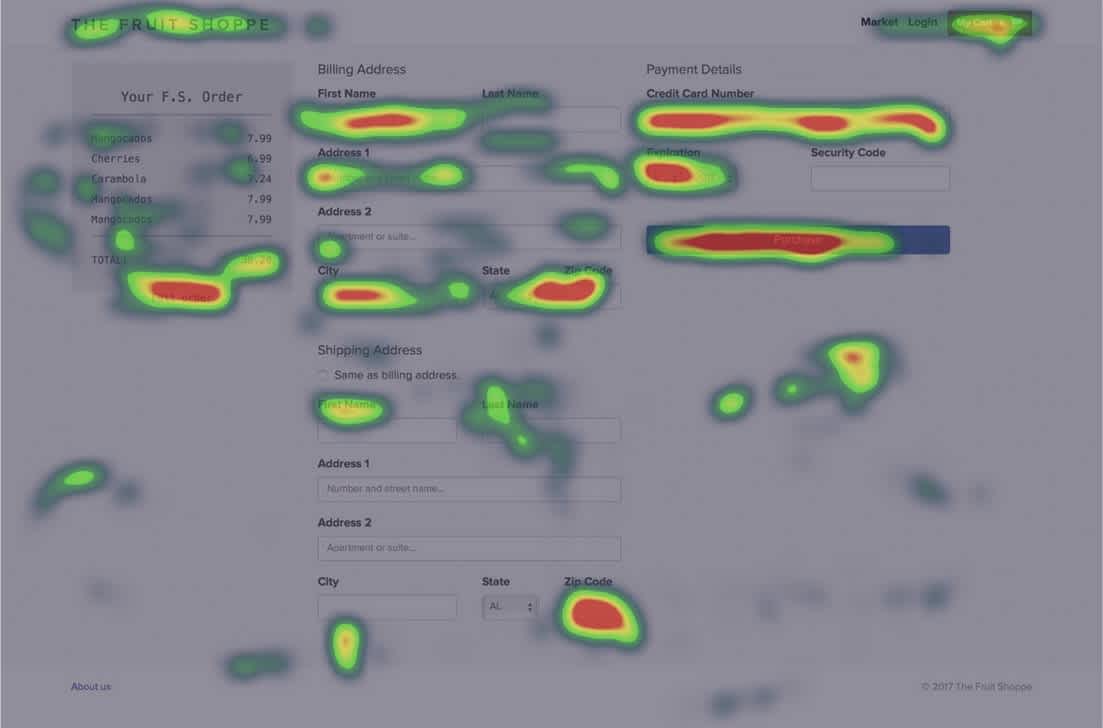
Many of the best digital customer experience tools come with different examples of heatmaps, like:
Attention heatmaps
Dot/click heatmaps
Attribution heatmaps
Behavior heatmaps
Each of these heatmap types can be beneficial for your organization and offer different levels or types of actionable insights.
Form analytics
Form analytics tools are also crucial for proper digital experience analytics data collection. These tools can track and measure customer experiences, then combine those with customer outcomes for form-based submission pages, such as email newsletter sign-ups, brand membership sign-ups, and so on.
Form analytics tools are important since they can reveal how your brand visitors interact with forms. Then your teams can take that data and identify:
Where people are most likely to abandon a form page
Which form pages are most successful
What potential trouble spots are present on your form pages
Journey discovery
Journey discovery tools show you popular user paths through your website or application, plus identify troublesome bottlenecks, confusion, or friction points where customers are more likely to abandon ship.
The best digital experience tracking and journey tools let you visualize user journeys. Then your team can quickly take action by streamlining or improving trouble spots while doubling down on the most successful journey funnels.
Segmentation
Don’t forget segmentation tools. Segmentation analytics tools allow you to focus on targeted content delivery for specific users.
Alternatively, these tools may help you identify different issues experienced by new users compared to repeat users, mobile users compared to desktop users, and more. In other words, segmentation tools help you identify the best and worst elements of your site/app journey for different segments of your user base. This may allow your team to tailor solutions for those groups individually to excellent effect.
Digital experience analytics tools and platforms
To get started leveraging digital experience analytics for your brand, you need to have the best analytics tools for your teams. Luckily, there are many analytics tools you can use starting today.
Fullstory
Fullstory has an expansive digital experience analytics tool suite. It includes a variety of high-quality tools to help you streamline your workflow, share data among team members, and help drive meaningful improvements across different teams.
Fullstory offers comprehensive Journey Mapping, Session Replay, and Funnels & Conversions Analysis, all while integrating seamlessly with your tech stack.
Find answers you need quickly and easily with Fullstory
Start gathering insights immediately from comprehensive, indexed, and searchable data. Find answers to questions you didn’t even think to ask.
Decibel
Decibel is a software tool suite designed to help teams discover and fix poor digital experiences. Its various features include funnel analysis tools, alerts, custom dashboards, and segmentation tools.
Glassbox
Glassbox offers AI-driven visualization and analytics tools. Its solutions include product management, marketing, compliance, and user journey visualization features.
Contentsquare
Contentsquare’s experience analytics platform focuses on in-page interactions and micro gestures. Customer behaviors are turned into scores and visualizations for faster team understanding of the data.
Google Analytics
You can’t forget Google Analytics: it's arguably the first major experience analytics software suite made available for everyone. This free tool suite is flexible and useful for marketers and small business owners who want to improve online conversion rates without paying for a tool. However, it doesn’t have the in-depth tools other software solutions have.
Amplitude
Amplitude includes cross-platform tracking, behavioral analytics, and customer support features.
